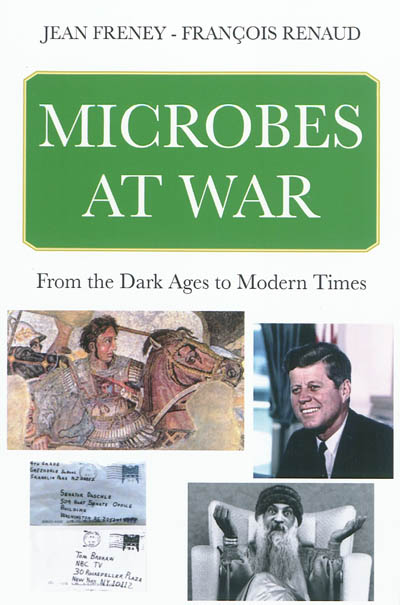en savoir plus

Permet à tous ses détenteurs d'obtenir 5% de réduction sur tous les livres lors du retrait en magasin (réduction non cumulable avec les réductions de type étudiant).
Offre également un certain nombre d'avantages auprès de nos partenaires.
Avec les favoris, retrouvez dans un espace les sélections effectuées au fur et à mesure de vos navigations dans le site.
Constituez pour votre usage personnel vos listes de livres en prévisions d'achats futurs et votre sélection d'articles, dossiers, événements, vidéos ou podcasts préférés ou à découvrir plus tard...
Il suffit simplement de cliquer sur "Ajout Favori" sur chaque page qui vous intéresse pour les retrouver ensuite dans votre espace personnel.
Requiert un compte Mollat
Requiert un compte Mollat
Microbes at war : from the dark ages to modern times
Auteur : Jean Freney
Auteur : François Renaud
en savoir plus
Résumé
Cet essai montre l'influence des maladies infectieuses sur l'évolution des faits historiques et en particulier sur les conflits politiques et militaires. Il retrace comment de tout temps, les hommes ont appris à vivre en présence des miasmes et même à les utiliser à des fins guerrières. ©Electre 2025
Quatrième de couverture
Microbes at war
This book illustrates how infectious diseases have influenced the outcome of numerous historical events, especially political and military conflicts. Even in ancient times, people learned to live in the presence of the so-called « miasmas » and in fact used them to scare the enemy. A particularly illustrative example is that of the siege of Syracuse in 416 BC, during which the Spartans cornered the Athenians into an area where swamp fever (malaria) was rampant and thus wiped them out. Similarly in the Dark Ages, human or animal cadavers used to be thrown into wells to contaminate the water and make it unfit for consumption. One of the strategies followed in the Middle Ages consisted of catapulting corpses of men who had died of plague into the enemy camp in order to spread the deadly infection. During the eighteenth century conflicts in North America, the British are known to have offered clothing contaminated with smallpox virus to the native Indians who were friendly with the French. Naturally occurring infections too have often upset the sequence of historical events, such as the epidemic of syphilis during the siege of Naples by King Charles VIII of France, or the English sweating sickness at the time of Lutheran Reformation. The Great Famine that was rife in Ireland in the nineteenth century was a result of a massive destruction of potato crops due to a fungal infection, and it eventually brought to power the first Catholic President of the United States of America, John Fitzgerald Kennedy. The epidemic of influenza known as « Spanish flu » significantly altered the course of World War I. At the turn of the century we see a scientific approach to the use of biological agents for military purposes with the aim of developing weapons of mass destruction, as depicted by the Japanese experiment in Manchuria during World War II. More recently, after the terrorist attacks of September 11, 2001, letter bombs carrying anthrax spores appeared, signaling the emergence of a particularly worrying phenomenon : bioterrorism.
Fiche Technique
Paru le : 02/12/2011
Thématique : Epidémiologie - Maladie Infectieuse
Auteur(s) : Auteur : Jean Freney Auteur : François Renaud
Éditeur(s) :
Eska
Collection(s) : Non précisé.
Série(s) : Non précisé.
ISBN : 978-2-7472-1547-3
EAN13 : 9782747215473
Reliure : Broché
Pages : 135
Hauteur: 24.0 cm / Largeur 16.0 cm
Épaisseur: 0.7 cm
Poids: 319 g

